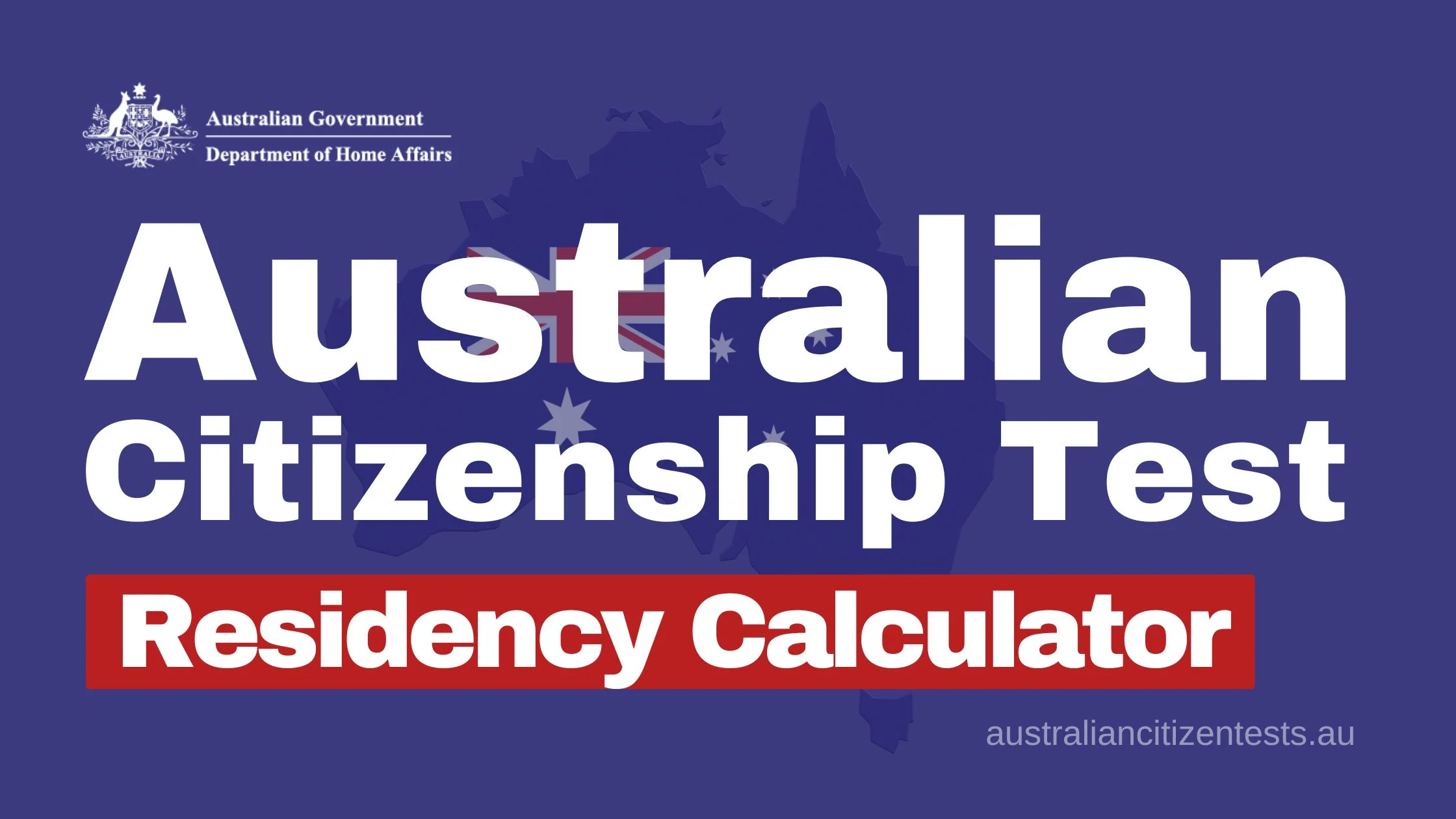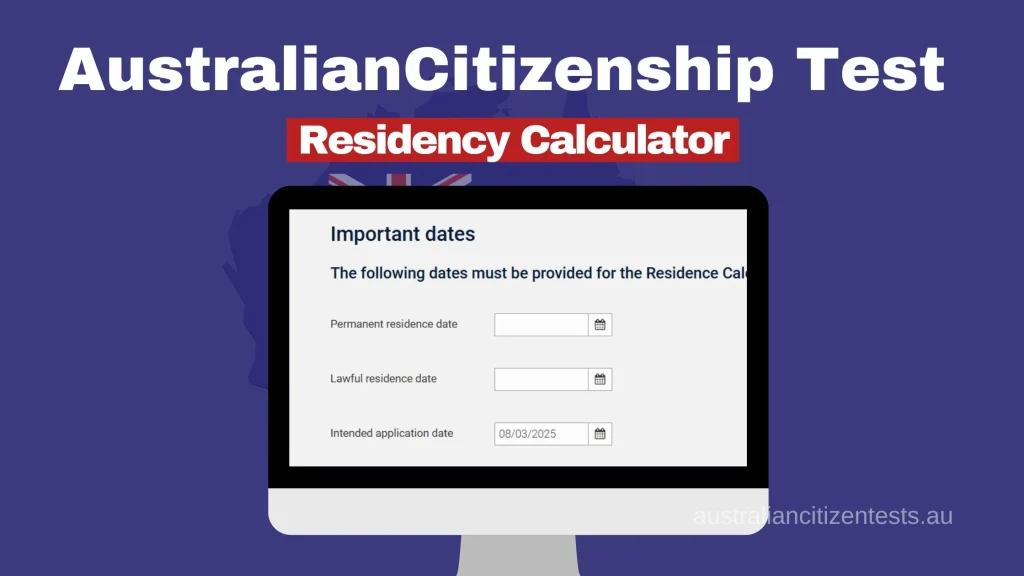
The Residence Calculator is an official tool provided by the Department of Home Affairs to help citizenship applicants check if they meet Australia’s residency rules. You need to enter exact dates—like when you became a permanent resident, the time you’ve lived lawfully in Australia, your planned application date, and all trips in/out of the country over the past four years. This helps the tool estimate whether you qualify.
Keep in mind: The calculator’s results are just an estimate. They don’t save or transfer to your actual citizenship application. Final approval depends on the Department’s official records when you submit your application. For exact travel dates, request your International Movement Records (a list of your trips abroad).
Core Residence Requirements (Calculator Basis)
The Residence Calculator determines eligibility based on lawful residence over the past four years, including temporary and permanent visa periods. It helps applicants check if they meet the Department of Home Affairs‘ citizenship requirements before applying.
4-Year Lawful Residence Rule
A person must have lived in Australia lawfully for four years, and the last 12 months must be on Permanent Residency (PR) or a Special Category Visa (SCV) for New Zealand citizens. Temporary visas, such as Subclass 482 (TSS Visa), count toward the four-year period, but only PR or SCV status qualifies for the final year. For example, if someone arrived on a 482 visa in 2012 and got PR in 2016, their lawful residence start date is still 2012.
Absence Limits
Citizenship applicants must follow strict travel restrictions. They cannot be absent for more than 12 months in total over the four-year period and cannot be away for more than 90 days in the 12 months before applying. Official records, like ImmiAccount travel records and International Movement Records, help verify these conditions. Those on a Resident Return Visa (RRV) should check how their travel history affects eligibility under the Australian Citizenship Act 2007.
Special Cases & Exemptions
Some applicants have unique situations that change how residency rules apply. The DHA allows special considerations, like how time overseas affects eligibility or how to handle missing residency records. Knowing these rules helps applicants meet citizenship requirements without confusion.
New Zealand Citizens (SCV/Subclass 189 Visa Holders)
New Zealanders with a Special Category Visa (SCV – Subclass 444) are treated as permanent residents for citizenship, even when traveling abroad. This means they keep their PR status and don’t lose eligibility due to absences. Those applying through the Subclass 189 (NZ Stream) may have their PR start date adjusted based on past time in Australia. Use the Residence Calculator and check with the Department of Home Affairs to confirm the correct residency rules for NZ citizens.
Using Estimated Dates
If you don’t remember your exact lawful residence dates, you can use estimates like “June 2012” in your application. The Residence Calculator allows approximate dates, but it’s best to verify them using International Movement Records or ImmiAccount. If these records aren’t available, a Statutory Declaration can support your application. This helps applicants meet eligibility even with missing travel details.
Step-by-Step Guide to Using the Calculator
The Residence Calculator helps you check if you meet Australia’s citizenship residency rules. Follow these steps to ensure accurate results and avoid mistakes.

Required Dates & Documents
To use the calculator, gather these details:
- Permanent Residence Date: Start date of your PR visa (grant date or first entry).
- Lawful Residence Date: First arrival in Australia on any valid visa (even temporary).
- Intended Lodgement Date: Planned application submission date (e.g., 23/02/2025).
- Travel Dates: All trips outside Australia in the past 4 years + future trips before applying.
Use documents like your PR Grant Notice, ImmiAccount records, or International Movement Records to confirm dates.
Adding Absences Correctly
Enter all absences in chronological order, including future trips before your application. Use International Movement Records (free from the Department of Home Affairs) for exact dates. If unsure, check passport stamps or travel history reports.
Warning: Missing even one trip can lead to errors. Double-check your entries to ensure accuracy.
Troubleshooting & Common Errors
Small errors in your citizenship application can slow it down or get it rejected. This section shows you how to fix common problems like wrong dates or missing travel info. Follow these steps to keep your application moving and meet the rules for living in Australia.
Handling Date Discrepancies
If the dates you put in the Residence Calculator don’t match the government’s records, you’ll need to show proof. Use things like boarding passes, rental agreements, or bank statements to back up your timeline. You can also check your travel history using International Movement Records (found in ImmiAccount).
If dates still don’t match, write a Statutory Declaration (a legal document where you swear your dates are correct). This helps explain gaps or mistakes. Always double-check your entries to avoid delays.
SCV Holder Considerations
New Zealanders with a Special Category Visa (SCV – Subclass 444) keep their PR-like status even when living overseas—as long as they had the SCV before leaving. Use the Residence Calculator to confirm your eligibility and follow the rules in the Australian Citizenship Act 2007 (the law for citizenship).
Keep records of your visa status and travel history to avoid problems. For example, save copies of your SCV grant and any trips abroad.
Post-Calculation Steps
After using the Residence Calculator, follow these steps to apply for citizenship. Your results will tell you if you’re ready to book the test or need to fix issues first.
If Eligible
Book your citizenship test through ImmiAccount using the Citizenship Appointment System. Prepare these documents:
- PR Grant Notice (proof of permanent residency).
- International Movement Records (travel history).
- Passport and ID.
Double-check your dates match the Department of Home Affairs records to avoid delays.
If Ineligible
If you don’t qualify yet, cut down on trips abroad or delay your application to meet the 90-day/12-month absence rules. Use the Residence Calculator to track progress and renew your Resident Return Visa (RRV) if needed. Fix gaps in your travel history report before reapplying.
Quick Fixes:
- Limit travel in the next year.
- Use a Resident Return Visa to keep PR status if staying overseas.
FAQs
Can I estimate my lawful residence date?
Yes! If you don’t know the exact date, use the Residence Calculator to estimate (e.g., “June 2012”). Support your guess with bank statements, rental agreements, or a statutory declaration.
What if I travel after using the calculator but before applying?
Update your travel dates in the Residence Calculator and recheck eligibility. Trips after using the tool but before applying count toward the 90-day absence limit.
What if I forgot a trip in my travel history?
Request International Movement Records (free via ImmiAccount) to fix errors. Submit a statutory declaration explaining the oversight if records are missing.
Can minor offences affect my residency eligibility?
Only if you hide them. Declare all offenses (even traffic fines). Minor issues won’t fail you if you’re honest and show rehabilitation.
Conclusion
The Residence Calculator is a helpful tool to check if you might qualify for the Australian citizenship test. But remember: its results are estimates, not guarantees. Always double-check your dates using travel records (like passport stamps or the ImmiAccount website) to match the government’s official data. Meeting the 4-year legal stay rule and travel limits takes careful planning—especially for New Zealanders on Special Visas or people who started with temporary visas.
Good preparation, honesty about travel history, and knowing special exceptions (like adjusted rules for NZ citizens) can avoid delays. If you don’t qualify yet, use the calculator to track your progress and plan travel wisely. By following Australia’s citizenship laws and staying organized, you’ll have a smoother path to becoming a citizen!
